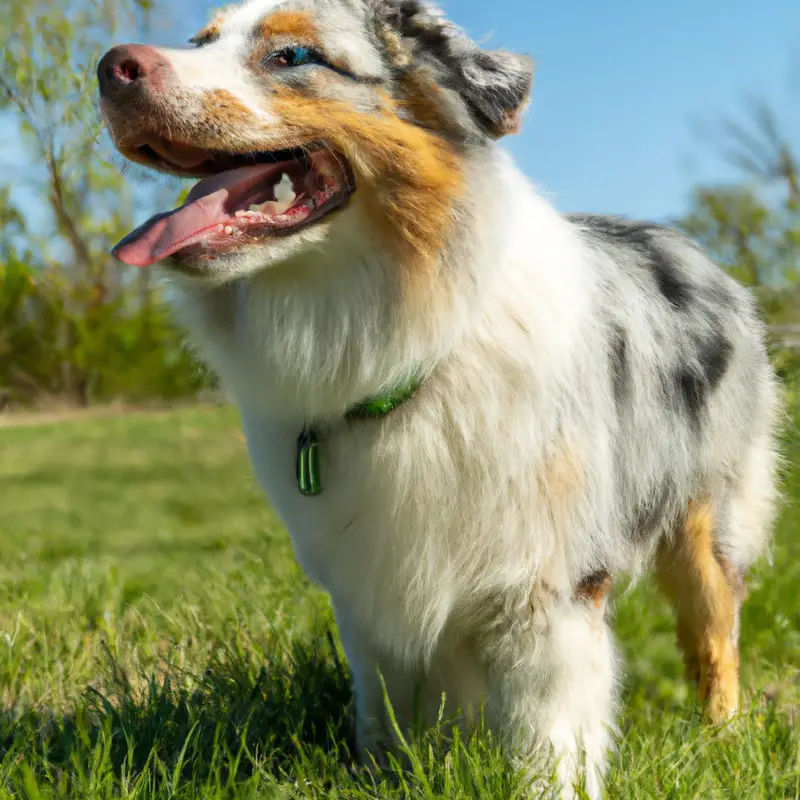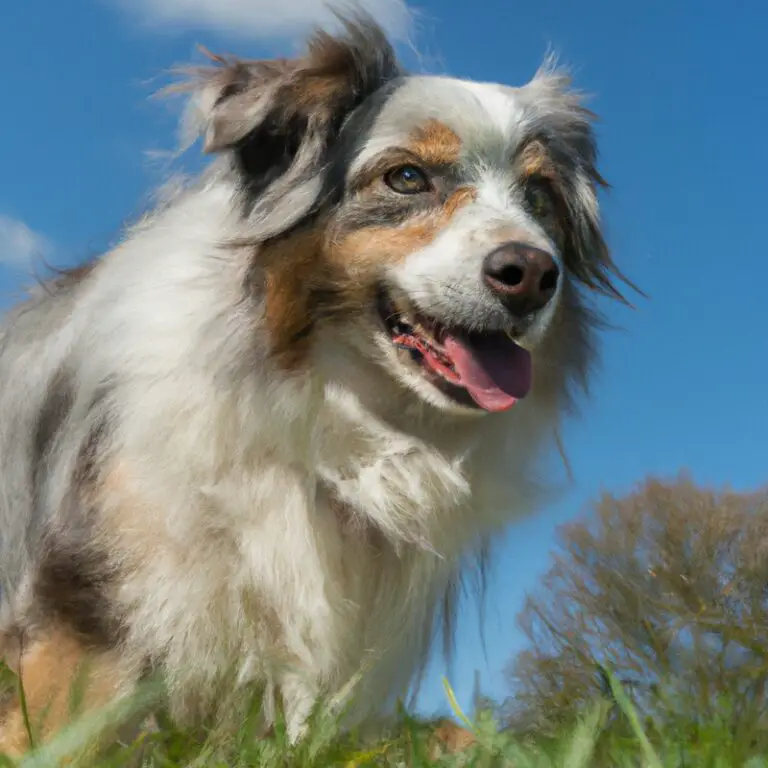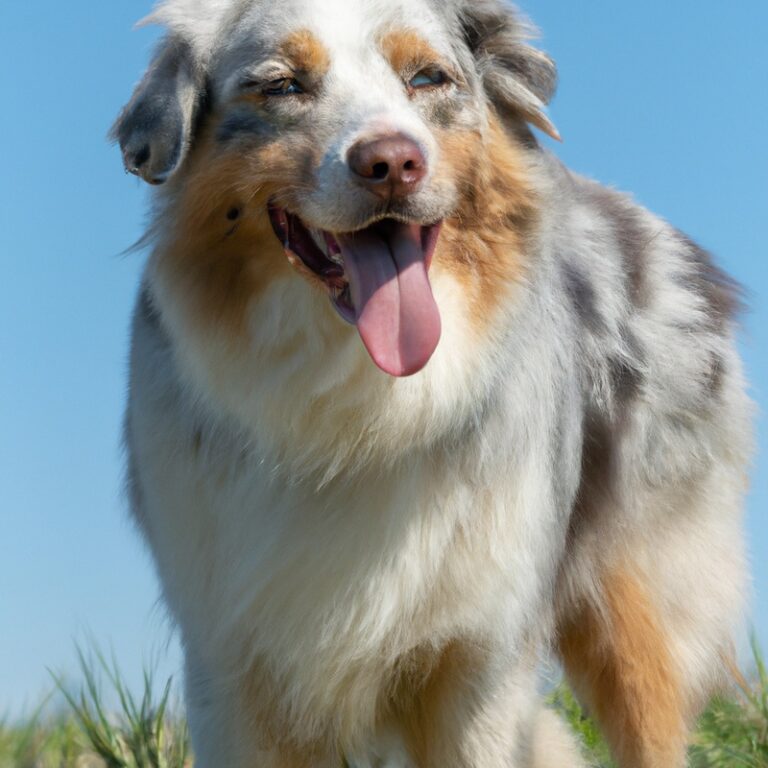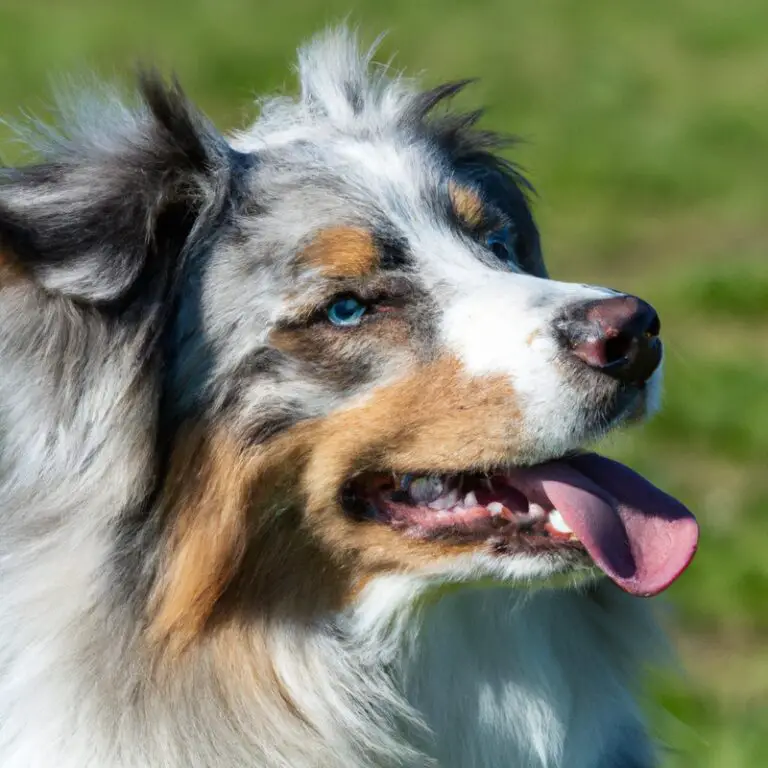Can Australian Shepherds Be Trained To Be Good With Rabbits?
Key Takeaways:
- Australian Shepherds have a strong herding instinct, making it challenging to train them to be compatible with rabbits.
- Early socialization and positive reinforcement can increase the chances of Australian Shepherds learning to coexist peacefully with rabbits.
- It is crucial to closely monitor and supervise interactions between Australian Shepherds and rabbits to ensure the safety of both animals.
- Some Australian Shepherds may never fully overcome their instinct to chase or herd rabbits, so individual personalities and training methods can vary.
Are you an Australian Shepherd owner who also happens to have rabbits as pets? The thought of your furry friends getting along harmoniously might seem like a far-fetched dream.
But fear not, because I’m here to shed light on the possibility of training Australian Shepherds to coexist peacefully with rabbits.
As a dog enthusiast with years of experience, I can assure you that with the right training and guidance, Australian Shepherds have the potential to be fantastic companions for rabbits. In this article, we’ll delve into the characteristics of Australian Shepherds, explore effective training techniques, discuss the introduction process, and provide tips on creating a safe environment for both your Aussie and rabbit pals.
So, let’s get started on this exciting journey towards rabbit-dog harmony!
| Question | Answer |
|---|---|
| Can Australian Shepherds be trained to be good with rabbits? | Yes |
Understanding Australian Shepherds and Their Characteristics
Overview of Australian Shepherds’ Temperament
Australian Shepherds have a unique temperament that sets them apart from other dog breeds. They are known for being intelligent, energetic, and highly trainable.
These dogs thrive on mental and physical stimulation, so they require an active and engaging lifestyle.
Australian Shepherds are often described as loyal and affectionate companions, forming strong bonds with their owners. However, they can also be quite reserved and protective around strangers.
It’s important to socialize them early on to ensure they are well-adjusted and friendly in different situations.
Australian Shepherds also have a strong herding instinct, which can make them prone to chasing small animals like rabbits. It is crucial to understand and manage this aspect when introducing them to rabbits.
Australian Shepherds’ Herding Instincts and Prey Drive
Australian Shepherds have strong herding instincts and prey drive. This means that they have a natural tendency to round up and control other animals, including rabbits.
These instincts are deeply rooted in their breeding and were originally developed for herding livestock on farms.
Herding instincts in Australian Shepherds can manifest in various ways, such as nipping at the heels of running animals or circling and barking to control their movements. While these behaviors may be useful when working with livestock, they can be problematic when it comes to small animals like rabbits.
The prey drive in Australian Shepherds is their instinct to chase and capture small, fast-moving creatures.
This drive is often triggered by movements, noises, or scents that resemble prey. When it comes to rabbits, their quick movements and unpredictable behavior can activate the Australian Shepherd’s prey drive, making them prone to chasing and even potentially harming the rabbits.
It’s important to be aware of these instincts and drives when considering whether Australian Shepherds can be trained to coexist with rabbits.
While training and socialization can help manage and redirect these instincts, it is crucial to remember that these instincts are deeply ingrained and may never completely disappear. With proper training and precautions, however, it is possible to create a safe and harmonious environment for both Australian Shepherds and rabbits.
Traits That Make Australian Shepherds Potential Rabbit Chasers
Australian Shepherds have certain traits that make them potential rabbit chasers. These traits include their herding instincts, high energy levels, intelligence, and agility.
Being a herding breed, Australian Shepherds have a natural inclination to chase and control small, moving animals.
Their high energy levels allow them to sustain a chase, and their intelligence helps them assess the situation and adapt their strategies accordingly. Additionally, their agility enables them to navigate through different terrains when pursuing prey.
These inherent traits make Australian Shepherds prone to chasing rabbits and other small animals.
Training Australian Shepherds to Coexist with Rabbits
Early Socialization and Exposure to Small Animals
Early socialization and exposure to small animals are important factors in training Australian Shepherds to coexist with rabbits. Introducing them to rabbits at a young age helps them develop positive associations and reduces the likelihood of prey-driven behavior.
By gradually exposing them to rabbits in controlled environments and reinforcing positive behavior, Australian Shepherds can learn to tolerate and even befriend rabbits.
It’s crucial to provide supervised interactions and monitor progress closely to ensure the safety and well-being of both the dog and the rabbit. Patience and consistency are key in this training process, and consulting a professional trainer can be beneficial if needed.

Positive Reinforcement Training Techniques for Australian Shepherds
Positive reinforcement training techniques are highly effective when it comes to training Australian Shepherds. By using positive reinforcement, we focus on rewarding desired behaviors rather than punishing unwanted ones.
This creates a positive and enjoyable training experience for both you and your dog.
One important technique is using treats or toys as rewards. When your Australian Shepherd performs a desired behavior, such as sitting or staying, immediately reward them with a treat or praise.
This reinforces the behavior and encourages them to repeat it in the future.
Consistency is key in positive reinforcement training. Make sure to use the same verbal cues and hand signals for each command, so your dog can learn to associate them with specific actions.
Be patient and repeat the training sessions regularly, keeping them short and engaging.
Another effective technique is clicker training. By associating a clicking sound with a reward, you can communicate with your Australian Shepherd more effectively.
When your dog performs the desired behavior, use the clicker to mark it and follow it with a treat.
This helps them understand exactly what they are being rewarded for. Remember to always be positive and upbeat during training sessions.
Praise your dog lavishly when they succeed and avoid scolding or punishing them for mistakes.
Positive reinforcement builds a strong bond between you and your Australian Shepherd, and makes training a fun and rewarding experience. So, focus on rewards, be consistent, use clicker training if desired, and always maintain a positive attitude.
With these positive reinforcement training techniques, you can help your Australian Shepherd become a well-behaved, happy companion.
Teaching Australian Shepherds Basic Obedience Commands
Teaching Australian Shepherds basic obedience commands is essential for their overall behavior and safety. When it comes to training, consistency is key.
Start with simple commands like “sit” and “stay.” Use positive reinforcement techniques, such as treats and praise, to reward good behavior.
It’s important to be patient and consistent with training sessions. Over time, gradually introduce more advanced commands like “down” and “come.” Remember to keep training sessions short and engaging to maintain your dog’s focus.
With time and practice, your Australian Shepherd will become a well-behaved and obedient companion.
Introducing Australian Shepherds to Rabbits
Controlled Environment Introduction
Controlled environment introduction is an important step in introducing Australian Shepherds to rabbits. It involves creating a safe and controlled setting for the initial interactions between the two.
This can be done by using baby gates or crates to create separate spaces for the dog and rabbit.
By gradually allowing supervised interactions in this controlled environment, you can assess the dog’s behavior and reactions towards the rabbit. This method helps in minimizing any potential risks and allows for a more gradual and controlled introduction.
Supervised Interactions between Australian Shepherds and Rabbits
Supervised interactions between Australian Shepherds and rabbits are essential for ensuring the safety and well-being of both animals. During these interactions, it’s crucial to closely monitor the behavior of the Australian Shepherd and the rabbit to prevent any negative incidents.
One important rule is to always keep the Australian Shepherd on a leash or in a controlled area when introducing them to a rabbit.
This allows you to have better control and intervene if necessary. Start with short supervised sessions, gradually increasing the duration as both animals become more comfortable with each other.
Observing body language is also key.
Look for signs of aggression or prey drive in the Australian Shepherd, such as intense staring, stiff posture, or raised hackles. If you notice these behaviors, redirect the Australian Shepherd’s attention to a positive activity, like playing with their favorite toy, to avoid any potential chasing or rough interactions.
Make sure the rabbit has a safe space to retreat to, like a separate enclosure or a high shelf, if they feel overwhelmed or scared.
This way, they can always have a sense of security during the interaction. Positive reinforcement plays a vital role in shaping good behavior.
Reward both the Australian Shepherd and the rabbit with treats or praise for calm and gentle interactions.
This helps them associate positive experiences with each other, fostering a more harmonious relationship over time. Overall, supervised interactions allow you to assess the compatibility between the Australian Shepherd and the rabbit, ensuring their safety while gradually building trust and familiarity.
Patience, consistency, and clear communication are key to creating a positive environment for both pets.
Gradual Desensitization and Positive Associations
Gradual desensitization and positive associations are key elements in training Australian Shepherds to coexist with rabbits. The process involves exposing the dog to the presence of rabbits in a controlled and gradual manner, while also associating positive experiences with their presence.
This can be done by initially introducing the dog to a rabbit’s scent or sound, and gradually progressing to visual encounters.
During the desensitization process, it’s important to monitor the dog’s behavior and ensure they remain calm and relaxed. Any signs of stress or arousal should be addressed immediately to prevent negative associations from forming.
It’s essential to take things at the dog’s pace, gradually increasing exposure as they become more comfortable.
Positive associations can be created by rewarding the dog with treats, praise, or play whenever they exhibit calm and relaxed behavior around rabbits. This helps to reinforce the idea that good things happen when rabbits are present.
Consistency and repetition are key in solidifying these positive associations.
Remember, every dog is unique, and the time it takes for them to become comfortable around rabbits may vary. Patience, consistency, and a gradual approach are vital for success.
If you’re unsure about the training process or encounter any challenges along the way, it’s always a good idea to consult a professional trainer who specializes in dog behavior and training.

Creating a Safe Environment for Rabbits and Australian Shepherds
Proper Housing and Separation Measures
Proper housing and separation measures are essential when it comes to creating a safe environment for rabbits and Australian Shepherds. Here are some tips:
- Provide separate living spaces: It’s important to have separate areas for your rabbits and Australian Shepherds. This could mean using different rooms or using sturdy barriers to divide the space. This prevents any unsupervised interactions that could lead to accidents or stress for both animals.
- Secure enclosures for rabbits: Ensure that your rabbits have a secure enclosure that protects them from potential harm. This could be a hutch or a cage with solid walls and a strong base. Make sure that the enclosure is escape-proof and provides enough space for your rabbits to move around comfortably.
- Designate dog-free zones: Set up specific areas in your home or yard where your rabbits can have some time without the presence of your Australian Shepherds. This allows your rabbits to relax and reduces the risk of any unwanted chasing or stress.
- Supervise interactions: When allowing your rabbits and Australian Shepherds to be together, always supervise their interactions closely. This allows you to intervene if necessary and prevents any potential harm to either animal. Gradually increase the duration of these supervised interactions as the trust between them grows.
- Separate feeding areas: Rabbits and Australian Shepherds have different dietary needs. To avoid any potential conflicts over food, provide separate feeding areas for both animals. This ensures that each animal has access to the appropriate food without any aggression or competition.
Remember, the safety and well-being of both your rabbits and Australian Shepherds are the top priority. By implementing proper housing and separation measures, you can create a harmonious environment where both animals can coexist safely.

Australian Shepherds’ Exercise and Mental Stimulation Needs
Australian Shepherds have high exercise and mental stimulation needs. They are an active and intelligent breed that thrives on physical activity and mental challenges.
Regular exercise is essential to keep them physically fit and prevent behavioral issues that may arise from pent-up energy.
To meet their exercise needs, Australian Shepherds should have daily opportunities for vigorous exercise such as long walks, runs, or playing fetch. Engaging in activities like agility training, herding, or obedience competitions can also provide mental stimulation and help fulfill their working instincts.
In addition to physical exercise, Australian Shepherds require mental stimulation to keep their minds sharp and prevent boredom.
Puzzle toys, interactive games, and obedience training sessions can provide mental challenges and prevent destructive behavior caused by boredom. It is important to note that Australian Shepherds are highly adaptable and can thrive in various living situations, as long as their exercise and mental stimulation needs are met.
So, whether you have a large backyard or live in an apartment, as long as you provide them with regular exercise and mental stimulation, they can be happy and content companions.
Remember, a well-exercised and mentally stimulated Australian Shepherd is a happy and well-behaved dog. So make sure to incorporate regular exercise and mental challenges into their daily routine to keep them physically and mentally fulfilled.
Rabbit-Proofing the Living Space
When it comes to creating a safe environment for your rabbits and Australian Shepherds, rabbit-proofing the living space is essential. Here are some tips to help you do just that:
- Secure the area: Make sure your rabbits have a designated enclosure that is escape-proof. Use sturdy fencing or wire mesh to prevent your Australian Shepherds from getting too close to the rabbits.
- Provide hiding spaces: Rabbits feel safer when they have places to hide. Provide them with wooden hideouts or cardboard boxes that are large enough for them to comfortably fit inside.
- Cover electrical cords and wires: Australian Shepherds, like any curious dog, may be tempted to chew on electrical cords. Cover exposed cords and wires or keep them out of reach to prevent any accidents.
- Remove toxic plants: Some plants are toxic to rabbits. Make sure your living space is free from any potentially harmful plants or flowers. Research which ones are safe for rabbits and remove any that are not.
- Store cleaning products safely: Keep cleaning products and chemicals in locked cabinets or out of reach of both rabbits and Australian Shepherds. These substances can be harmful if ingested.
- Keep small objects out of reach: Rabbits are curious creatures, and they may nibble on small objects. Keep any small items, such as buttons or coins, out of their reach to prevent them from swallowing something dangerous.
Monitoring and Assessing Progress
Identifying Warning Signs and Red Flags
Identifying warning signs and red flags is essential when training Australian Shepherds to be good with rabbits. Here are some indicators that might suggest potential issues:
- Aggressive Behavior: Pay attention if your Australian Shepherd displays any signs of aggression, such as growling, snarling, lunging, or biting towards rabbits or other animals.
- Excessive Chasing: While Australian Shepherds have a natural herding instinct, excessive chasing can be problematic. If your dog constantly chases or obsessively fixates on rabbits, it may indicate a lack of control or potential aggression.
- Lack of Interest in Training: If your Australian Shepherd shows disinterest or stubbornness during training sessions involving rabbits, it could be a sign that they are not receptive to the desired behavior.
- Inability to Follow Basic Commands: If your dog consistently fails to respond to basic commands, like “leave it” or “come,” when rabbits are present, it may signify a difficulty in controlling their instincts or a lack of training.
- Prey Drive Intensity: While some level of prey drive is expected in Australian Shepherds, an extremely high prey drive may make it challenging for them to coexist peacefully with rabbits. Monitor how intense your dog’s prey drive is and evaluate whether it can be managed through training.
Remember, every dog is unique, and it is important to gauge their individual behavior. If you notice any warning signs or red flags during the training process, it’s crucial to address them promptly.
Seek guidance from a professional dog trainer or behaviorist who can provide you with personalized advice and assistance in creating a safe environment for both your Australian Shepherd and rabbits.
Importance of Patience and Consistency in Training
Training Australian Shepherds to be good with rabbits requires patience and consistency. It’s important to remember that dogs, like humans, need time to learn and adjust to new behaviors.
Rushing the training process can lead to frustration and setbacks.
Consistency is key in reinforcing desired behaviors and ensuring that your Australian Shepherd understands what is expected of them. Training should be done regularly and with the same rules and cues.
This will help your dog develop a clear understanding of their boundaries and expectations.
So, while it may take some time, being patient and consistent in your training will ultimately lead to success in establishing a harmonious relationship between your Australian Shepherd and rabbits. Keep up the hard work!
Consulting a Professional Trainer if Necessary
If you find that training your Australian Shepherd to coexist with rabbits is not going as smoothly as you hoped, it may be time to consider consulting a professional trainer. They have the expertise and experience to assess the situation and provide you with guidance and effective training techniques.
A professional trainer can help identify any behavioral issues or challenges that may be impeding progress and create a customized training plan tailored to your specific needs.
They can also offer valuable advice on managing and modifying your dog’s behavior around rabbits. Remember, seeking professional help can make a significant difference in improving the relationship between your Australian Shepherd and rabbits.
Final Verdict
Australian Shepherds can indeed be trained to coexist peacefully with rabbits with the right approach and training techniques. Early socialization, positive reinforcement, and teaching basic obedience commands are crucial in preparing Australian Shepherds for interactions with rabbits.
Controlled introductions, supervised interactions, and gradual desensitization can help foster a safe and harmonious relationship.
It’s important to create a safe environment for both pets, provide proper housing and exercise, and regularly monitor progress. Patience, consistency, and seeking professional help if needed are key to success.
With the right training and guidance, Australian Shepherds can learn to be good companions to rabbits, promoting a happy and safe environment for all.







